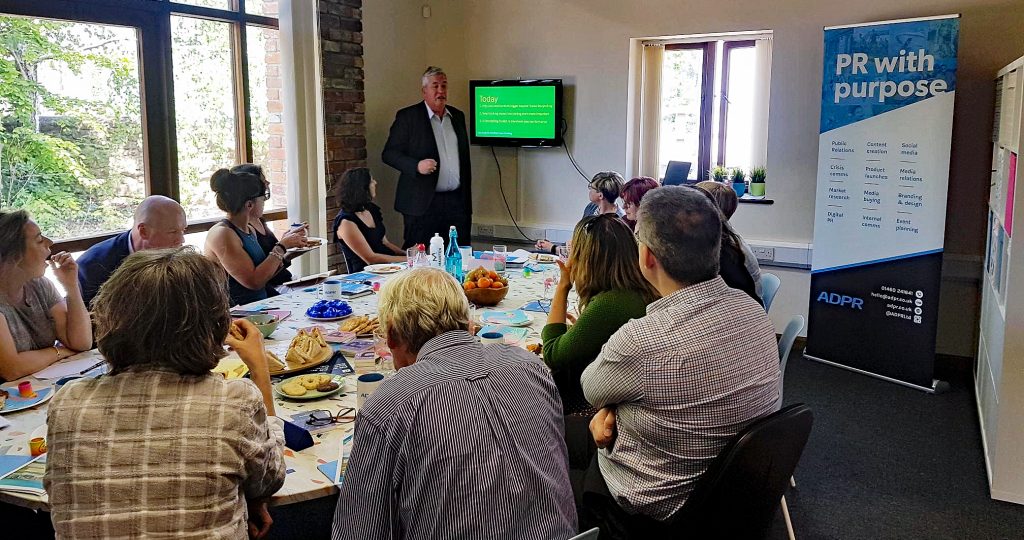As the county champions for the PRCA, we were pleased to welcome more than 15 of the region’s leading creative minds to the office this week to hear from international branding expert, Andy Green, who gave an insight into how develop brand storytelling.

The role of PR
It is imperative that, as communication professionals, we transform our thinking to keep our audience engaged and clients at the forefront of their markets. We’re in the industry of rapid change, with information and knowledge readily available for everyone. Therefore the content we create should be of value to the target market, it must tell your brand story accurately and it should lead to a specific action or behaviour change.
Every brand has a story to tell and telling yours ‘better’ gives competitive advantage. By using the five steps below, we can transform our brand communications:
Have a purpose.
Ask yourself – why are we here? What is our goal? It’s a social purpose, to interact with our audience to earn confidence to co-exist, cooperate and collaborate, to ultimately earn trust – something which cannot be bought.
The new brief.
To create the perfect platform to build your new brief, consider how the brand is:
- Known – generally (do people know who it is?) and how is it known by its peers, competitors, the world?
- Liked – by others – do people like the brand?
- Trusted – around the world, by others?
- Front of mind – have people heard from it or about it recently?
- Being talked about – what is being said?
Emergence theory.
How can the brand emerge from the situation or context, rather than designing or constructing it? For example, an advert emerges from the need to be known and noticed. Whereas, PR emerges from the need to be trusted and earning that trust from a third party. These two do not need to act in isolation, but rather in tandem to generate the best possible results overall.
The evolution of PESO.
- Paid content – adverts, advertorials, etc
- Earned content – PR
- Shared content – social channels and content hosted on the internet
- Owned content – content on your website, social media, brand, literature, etc
This formula has been used for many years in this order (with the preference being on paid-for content), however it has been proven to be more valuable for brands to evolve PESO to OESP or OSEP.
Thinking bigger.
“Communications” is bigger than just integrated marketing. By looking at the bigger picture, we can start to write a new era of earned trust, new opportunities and a greater confidence. Ultimately, we want to earn trust and we can do this by:
- Listening
- Behaviours – brand counsel, how you act
- Social capital – who you know, your shared identities and helping each other
- Managing your narrative, story, news, content, conversations…
- Trust – focused activities to earn trust
Developing your storytelling toolkit
Effective storytelling can make communications more distinctive, compelling and authentic. A brand’s narrative should sit above the content we are creating and should be interwoven throughout the earned, owned, shared and paid-for content.
Some of Andy’s top tips to help you tell your brand story more effectively:
Key plots for your content:
- Tragedy – and how your brand/product/person overcame this
- “Rags to riches”
- Overcoming the “monster” – this is something that can damage your brand/reputation
- The journey – of a brand/product/person
- A re-birth – transformational/inspirational story
Choose a theme for your piece:
- The desire for Justice
- The pursuit of Love
- Morality of individuals when choices have to be made
- A desire for Order
- The pursuit of Pleasure
- The fear of Death
- The fear of the Unknown/Unknowable
- The desire for Validation
And choose persona for your story – who is telling your story:
- Ruler – king or queen of the sector
- Hero – someone who is saving the day/issue
- Outlaw – a “naughty” hero
- Innocent party – a non-bias person or organisation
- Sage – an expert or someone who knows a lot about the topic
- Creator – a creative expert on the matter – note, this persona cannot be used alone
- Regular – someone reliable on the subject
- Lover – offering extra care and attention or TLC
- Caregiver – such as the NHS
- Explorer – an adventurer
- Magician – but don’t ask them how they know it or how they do it
- Jester
By having clarity of the above, you can better understand your narrative and tell a much clearer and more powerful story throughout your content. And dependent on the brief, you should change the persona and script to meet these needs.
Our role within PR is evolving. We can now be the orchestrators of content and strategies, thus being instrumental in helping to advise businesses on what they need to do to achieve their goals.
For more of our communications and consumer PR, please see ADPR’s Consumer PR 101
For more information on how we might be able to help you, please contact Sophie Foyle: sophie@adpr.co.uk / +44 (0) 1460 241641.

